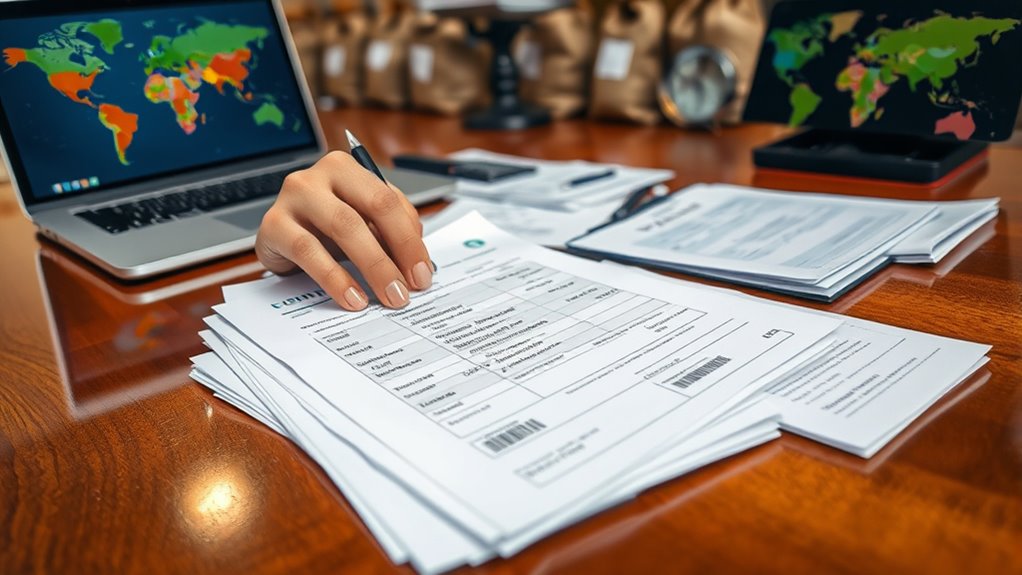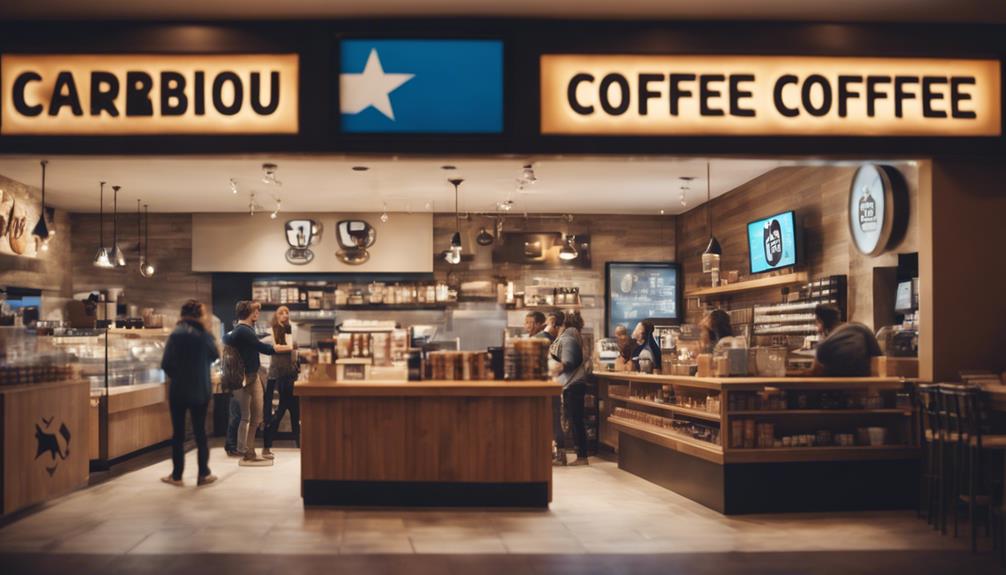When exporting coffee, you need to prepare accurate documents like commercial invoices, packing lists, and bills of lading to meet international standards. These papers verify product quality, origin, and shipment details, helping customs clear your goods smoothly. Properly aligned documentation prevents delays, reduces costs, and ensures compliance with regulations. If you want to understand how to manage these documents effectively and streamline your export process, keep exploring the key steps involved.
Key Takeaways
- Export documentation includes essential papers like commercial invoices, packing lists, bill of lading, certificate of origin, and phytosanitary certificates.
- Accurate and complete documents ensure smooth customs clearance and prevent shipment delays or rejections.
- Proper documentation confirms product compliance with quality standards and aligns with shipping procedures.
- Correct paperwork facilitates international trade, supports regulatory compliance, and ensures timely delivery of coffee.
- Managing export documents effectively reduces risks, costs, and enhances professionalism in the coffee export process.

Are you prepared to navigate the complex world of export documentation for coffee? If so, you need to understand that quality standards and shipping procedures are the backbone of smooth international trade. The first step involves ensuring your coffee meets the required quality standards set by importing countries. These standards, often outlined by organizations like the International Coffee Organization or national agencies, specify parameters such as moisture content, bean size, defect levels, and overall cleanliness. You must conduct thorough testing and obtain certifications that verify your product complies with these standards. Having the right documentation that confirms your coffee’s quality helps prevent delays at customs and reassures buyers of your product’s consistency.
Ensuring coffee meets international quality standards prevents delays and reassures buyers.
Once your coffee passes quality assessments, you’ll need to prepare shipping procedures that align with international regulations. Shipping procedures cover everything from packing to transportation logistics. Proper packaging is essential; it must protect your coffee from damage, contamination, and moisture during transit. You’ll typically use burlap bags, vacuum-sealed packs, or specialized export containers, depending on the buyer’s specifications. Accurate documentation of these procedures can be *crucial*, especially if customs officials need to verify the integrity and safety of your shipment. Additionally, understanding the Gold IRA Rollovers process can ensure you effectively diversify your investment portfolio, which can be a strategic move for long-term financial stability.
The core documents supporting export activities include the commercial invoice, packing list, bill of lading, certificate of origin, and phytosanitary certificate. The commercial invoice details the transaction, describing the quantity, price, and product specifications. The packing list provides an itemized account of the shipment, helping customs and logistics companies verify the contents. The bill of lading acts as a contract between you and the carrier, confirming receipt of the goods and authorizing their transport. Meanwhile, the certificate of origin verifies where your coffee was produced, which can impact tariffs and import restrictions. If your coffee requires phytosanitary certification to prevent pests or disease transfer, securing this document is *vital*.
All these documents must be accurate and complete before your shipment departs. Any discrepancies or missing paperwork can cause delays, additional costs, or even rejection of your shipment. It’s *important* to double-check that all details align with your shipping procedures and quality standards. As you prepare your export documentation, stay up-to-date on specific country requirements, as regulations can vary. Properly managing these documents ensures your coffee moves efficiently through customs, gets delivered promptly, and maintains its integrity. Mastering the interplay between quality standards and shipping procedures in your documentation process makes exporting coffee a smoother, more reliable venture.
Frequently Asked Questions
How Long Does the Export Documentation Process Typically Take?
The export documentation process usually takes anywhere from a few days to a week, but export delays can extend this timeline. To avoid delays, you need to guarantee documentation accuracy and completeness from the start. Promptly providing all required paperwork and double-checking details helps speed things up. Being proactive reduces the risk of hold-ups, so plan ahead and verify your documents thoroughly to keep the process running smoothly.
Are There Specific Certifications Required for Exporting Coffee?
Think of certification as your coffee’s passport to the world. You need to meet quality standards and pass certification processes like Organic, Fair Trade, or ISO, depending on your target market. These certifications verify your coffee complies with international standards, boosting buyer confidence. You should check specific country requirements, as some may demand additional certifications. Staying compliant helps you smoothly navigate export documentation, making your coffee’s journey seamless.
What Are Common Mistakes to Avoid in Export Documentation?
You should double-check export documentation for accuracy to avoid delays and compliance issues. Common mistakes include incorrect product descriptions, missing signatures, or outdated certificates, which can lead to export compliance violations. Always verify that all paperwork matches shipment details precisely, and make certain all required certifications are current. By paying close attention to documentation accuracy, you help prevent costly errors and streamline your coffee export process.
How Do Tariffs Affect Coffee Export Documentation Requirements?
Tariffs impact coffee export documentation by requiring you to adhere to tariff regulations and accurately declare customs duties. You need to include detailed information about the tariff classification and applicable duties on your documents to avoid delays or fines. Failing to understand these regulations can lead to shipment holds or extra costs. Staying informed about tariff changes ensures your export process remains smooth and compliant with all customs requirements.
Can Export Documentation Be Handled Remotely or Online?
Imagine you’re in the age of dial-up internet, but today, you can handle export documentation for coffee remotely. You can easily use online portals to submit required forms and leverage digital signatures for security and efficiency. This digital approach streamlines the process, saves time, and reduces errors, making managing export documentation more convenient than ever. Embrace technology, and you’ll find handling export paperwork is now faster and more accessible than a telegram in the 1920s.
Conclusion
Just as a master barista carefully prepares each cup, your understanding of export documentation guarantees your coffee reaches the world’s tables seamlessly. Remember, the journey of your beans mirrors the odyssey of knowledge—complex, precise, and essential. By mastering these documents, you become a custodian of quality and trust, turning an intricate process into a smooth voyage. As with fine coffee, it’s the details that make all the difference in crossing borders successfully.









